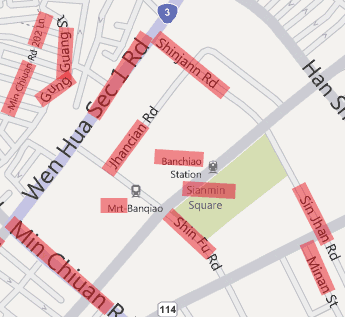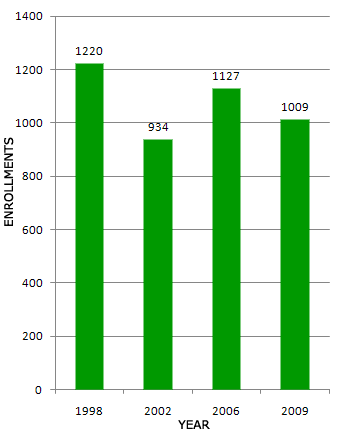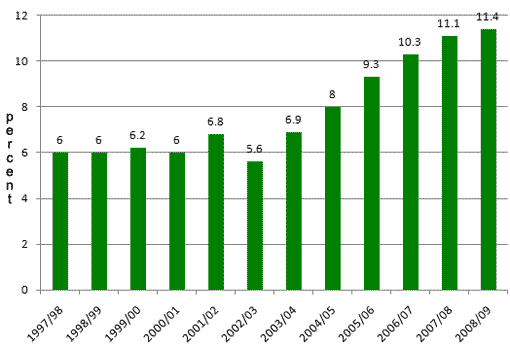The maps of Taiwan put out by GooGle are plagued with errors in their use of Pinyin. But what about that other big company with deep pockets? You know: Microsoft. How good a job does Microsoft’s Bing do with its maps of Taiwan?
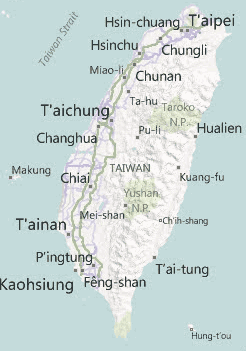
I won’t keep y’all waiting: After examining Bing’s maps of Taiwan the two words that came first to mind were incompetent and atrocious.
The country-level map is odd, offering Wade-Giles. And although the use of the hyphen is irregular, I will give Bing points for getting at least Wade-Giles’ apostrophes right. So, although some place names on the map are decades out of date (e.g., Hsin-chuang, Chungli, Chunan, Kuang-fu), at least they’re not horribly misspelled within that system.
It’s at the street level that Bing’s weirdness becomes most apparent. For example, below is part of Bing’s map of Banqiao.
I added the highlighting.
This tiny but representative fragment of the map has not one but four romanization systems:
- MPS2: Gung Guang, Min Chiuan, Shin Fu (Even within MPS2, none of those should have spaces or extra capital letters.)
- Hanyu Pinyin: Banqiao (This is the only properly written place name on this map fragment.)
- Tongyong Pinyin: Jhancian, Sianmin, Sin Jhan
- Gwoyeu Romatzyh(!): Shinjann (This is the same road as the one marked “Sin Jhan”. In Hanyu Pinyin, which is what officially should be used here, this is written “Xinzhan”.)
A few more points about this small fragment of the map:
- Wen Hua could be either MPS2 or Hanyu Pinyin, but not Tongyong Pinyin. And it should be Wenhua.
- Minan is missing an apostrophe. (It should be Min’an.)
- Banchiao is just wrong, regardless of the system. They were probably going for MPS2 but erroneously used an o instead of a u: Banchiau.
- Sec 1 Rd should be Rd Sec. 1.
- Mrt should be MRT.
So that’s four systems, plus additional errors.
There’s much, much more that’s wrong with this than is right. That’s even more evident on a larger map — and that’s without me bothering to mark orthographic problems in the Pinyin (e.g., Wen Hua instead of the correct Wenhua).
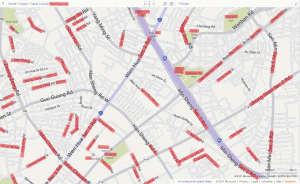
Here bastardized Wade-Giles (e.g., “Mrt-Hsinpu” at top, center — and, FWIW, in the wrong location) has been added to the mix, making a total of five different romanization systems, as well as some weird spellings, e.g., U Nung, Win De, Bah De, Ying Sh — and that’s without including my favorite, JRLE, because that one is correct in MPS2 (“Zhile” in Hanyu Pinyin).
The main point is that vast majority of names are spelled wrong. And among the few that are spelled correctly, those that are written with correct orthography can be counted on one hand. So, to the words above (incompetent and atrocious) let me add FUBAR.
The copyright statement lists not only Microsoft but also Navteq. The Taiwan maps on the latter company’s site, however, are different from those on Bing. Navteq’s are generally in Hanyu Pinyin, though almost invariably improperly written (e.g., Tai bei Shi, Ban Qiao Shi). And despite the prevalence of Hanyu Pinyin, they still contain other romanization systems (e.g., Jhong Shan) and outright errors (e.g., Shin Jahn).

So an update from Navteq wouldn’t be nearly enough to fix Bing’s problems, which are fundamental.
, also covers this topic.






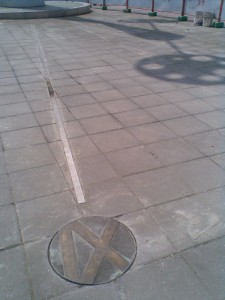
 I contacted the Taipei City Government about this. They said to contact the Taiwan High Speed Rail Corporation, which I did. They, in turn, responded that I’d reached the wrong office and should write a different office; but they didn’t forward the message or provide me with the correct e-mail address. Once I’d tracked down another office I e-mailed the folk there. That was more than a week ago. There has been no response.
I contacted the Taipei City Government about this. They said to contact the Taiwan High Speed Rail Corporation, which I did. They, in turn, responded that I’d reached the wrong office and should write a different office; but they didn’t forward the message or provide me with the correct e-mail address. Once I’d tracked down another office I e-mailed the folk there. That was more than a week ago. There has been no response. 
